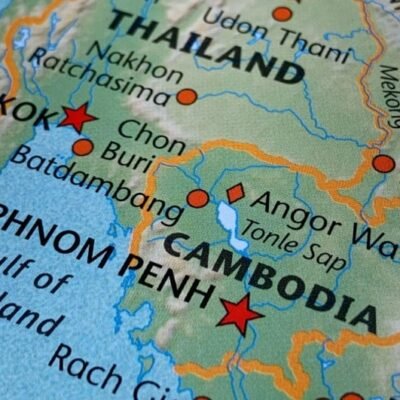Tigers are undoubtedly the creature that captivates most travellers to India, but the country has more to see than Shere Khan, the famous Bengal tiger in The Jungle Book. Sloth bears, rhinos, crocodiles, peacocks, leopards, and sambar deer all call India’s forests home, as does the mighty Asian elephant, which can weigh up to 5,400kg (11,900 lbs). With so many iconic Indian animals and more than 100 national parks in which to see them, it can be hard to know where to go to give yourself the best chance of finding Baloo, Bagheera, Kaa, and co. This handy guide to the national parks of India should get you on the right track.
Ranthambore National Park
Famed for its population of tigers, which is thought to number around 80, Ranthambore is one of India’s most visited national parks, and you can see why; this former hunting reserve of the Maharajas is also one of the easiest national parks in the country to reach. Located just 130km (80 mi) from the “Pink City” of Jaipur, Ranthambore makes a feasible day trip, and given that this is one of the best places in the whole country to see a tiger, it’s worth a visit. Of course, there’s more to this park than just tigers. Leopards, striped hyenas, golden jackals, mugger crocodiles, and sloth bears all call the park home, and the UNESCO-listed Ranthambore Fort within the park boundaries dates from the 10th century.
Experience it for yourself on: Rajasthan Adventure
Jim Corbett National Park
Named after the naturalist and “hunter of man-eaters” Jim Corbett, who played a major role in its establishment as a protected area, this national park was the country’s first. Spread across 520 sq km (201 sq mi) of open grasslands, rolling hills, marshes, and forested ravines, Jim Corbett National Park is famous for its herds of elephants, which are often seen hanging out in the grasslands by the Ramganga River. While tiger sightings are rare, you stand a good chance of seeing jackals, langur monkeys, sambar deer, and critically endangered gharial (fish-eating crocodiles), as well as 600-plus species of birds.

Gir National Park
There are lions in India? Yes, but Gir National Park in Gujarat is the only place you’ll find them. Once the private hunting lodge of the Nawab of Junagadh in the days of the British Raj, Gir National Park was established as a wildlife sanctuary in 1965 to protect the Asiatic lion, whose population was almost entirely wiped out. It’s been a significant success story, and this mighty big cat now numbers around 650 individuals. Aside from lions, you might also spot four-horned antelopes, golden jackals, Bengal foxes, wild boars, nilgai, and mongoose. If you’re here at dawn or dusk, keep your eyes peeled for porcupines, striped hyenas, and honey badgers.
Bandhavgarh National Park
Billed as the best place in India to see a tiger, Bandhavgarh has reached almost legendary status among wildlife watchers and naturalists. A family of tigers living here was featured in the 2018 BBC documentary Dynasties, and the park is famous for having the highest density of tigers anywhere in the world. If you’re looking to come face to face with one of these legendary beasts, Bandhavgarh is the place to go. Of course, the park is home to more than just tigers. Plenty of leopards roam, as well as sloth bears, nilgai antelope, barking deer, caracals, and Indian wolves.
Kanha National Park
Rumour has it that British author Rudyard Kipling used Kanha as inspiration for his 1894 novel The Jungle Book. This vast wilderness is one of India’s largest national parks, and it encompasses a whopping 940 sq km (360 sq mi) of sal forests, grassy meadows, and bamboo groves where all kinds of creatures reside. The star of the show is arguably Shere Khan the tiger, but with luck, you may also spot Baloo the sloth bear and Bagheera the panther. Add in packs of dhole (wild dogs), chital deer, and the barasingha swamp deer, which was brought back from the brink of extinction in this very place, and you can see why Kanha is considered one of India’s best national parks.

Nagarhole National Park
Part of the sprawling Nilgiri Biosphere Reserve, the largest protected forest in India, Nagarhole translates to “snake river,” which is exactly what the Kabini River does throughout the park. It’s another of India’s tiger reserves, and Nagarhole has a fairly stable population residing in its lush, forested valleys and hills. Other species you might spot here include gaur, elephants, sambar, dhole, sloth bears, and Indian giant flying squirrels. The real jewel in Nagarhole’s crown is its famous melanistic leopard or “black panther.” Known as Saya, this magnificent animal is a sight to behold. Find him in the Kabini area of the park.
Periyar National Park
Kerala is well-known for its waterways, and you’ll certainly find plenty of H₂0 in Periyar National Park. Based around the sprawling artificial Periyar Lake, this vast reserve is known for its boat safaris, which ferry visitors up and down the shoreline in early morning and evening stints. It’s an incredibly scenic place, and you have a good chance of spotting wildlife heading to the water to drink, particularly during the hottest months of the year. Species resident here include elephants, dhole, lion-tailed macaques, wild boars, and gaur, and you may spot smooth-coated otters dipping and diving through the lake, too.
Top tip: Opt for a bamboo raft safari instead of a boat because the noise of the boat engines often scares away wildlife.
Experience it for yourself on: Best of Southern India
Kaziranga National Park
Home to two-thirds of the world’s one-horned rhinos, UNESCO-listed Kaziranga is worth the somewhat arduous trip to Assam. More than 2,500 individuals are found here, so you’re practically guaranteed to see one grazing in the swampy grasslands for which the park is so famous. Other species found here include herds of elephants, wild water buffalo, gaur, and barasingha swamp deer, which are all often spotted by the banks of the mighty Brahmaputra River. Bird-watchers will be more than happy, too. Wreathed hornbills, fish eagles, and Blyth’s kingfishers are often seen, and if you’re lucky, you might witness India’s only ape, the hoolock gibbon, swinging in the canopy.

Pench National Park
Another one of the best places in India to spot tigers, Pench National Park was also used as inspiration for Kipling’s legendary book. It’s less popular than nearby Kanha or Bandhavgarh, which means that you’ll often feel like you’ve got the park to yourself. It predominantly consists of dry deciduous forests, so keep your eyes peeled for sloth bears, nilgai, leopards, wild boars, sambars, jackals, peacocks and a plethora of other bird species, and that black-and-orange-striped star.
Hemis National Park
High in the mighty Himalaya, Hemis National Park is a beautiful spot and one of the best places on Earth to see a snow leopard, the so-called “ghost of the mountain.” These shy yet majestic felines are notoriously hard to spot, yet this national park — India’s biggest — has earned the title of having the most snow leopards of anywhere in the world. To get even the slightest chance of spotting one, you need to visit in winter (November through March), when they descend from their high summer retreats to hunt Asian ibex, bharal (blue sheep), and argali (mountain sheep). Although you may not spot a snow leopard, you stand a good chance of spotting golden eagles and griffon vultures as they soar past the towering peaks of the Himalayas on thermoclines. Don’t miss the opportunity to take on the Markha Valley Trek, one of the most scenic trails on the planet.

Valley of Flowers National Park
Nestled high in the western Himalayas lies this remote and tiny national park, which measures just 87 sq km (34 sq mi). As you can probably tell by the name, this UNESCO-listed pocket of Uttarakhand is famous for its wildflowers, which bloom in bugyals (high-altitude meadows) in July, August, and September. The whole place is transformed into a colourful carpet, and it’s worth a visit to see the 300 different species of flowers, not to mention the incredible panoramic views of the Himalayas. In terms of wildlife, you might catch a glimpse of a musk deer, lammergeier, Himalayan vultures, and Asian black bears.
Sundarbans National Park
Sunderbans National Park contains the world’s largest mangrove forest, which is criss-crossed by a labyrinthine network of canals, creeks, mudflats, and tidal rivers. Trips into this expansive, protected area are done by boat, and if you’re lucky, you might be able to glimpse a Bengal tiger swimming from island to island. While sightings are rare, they’re not completely out of the question. Other lucky sightings include the critically endangered Ganges river dolphin. The national park is a highly important area for numerous species of migratory birds, as well as saltwater crocodiles, otters, fishing cats, pythons, terrapins, and king cobras — the world’s largest venomous snake.





